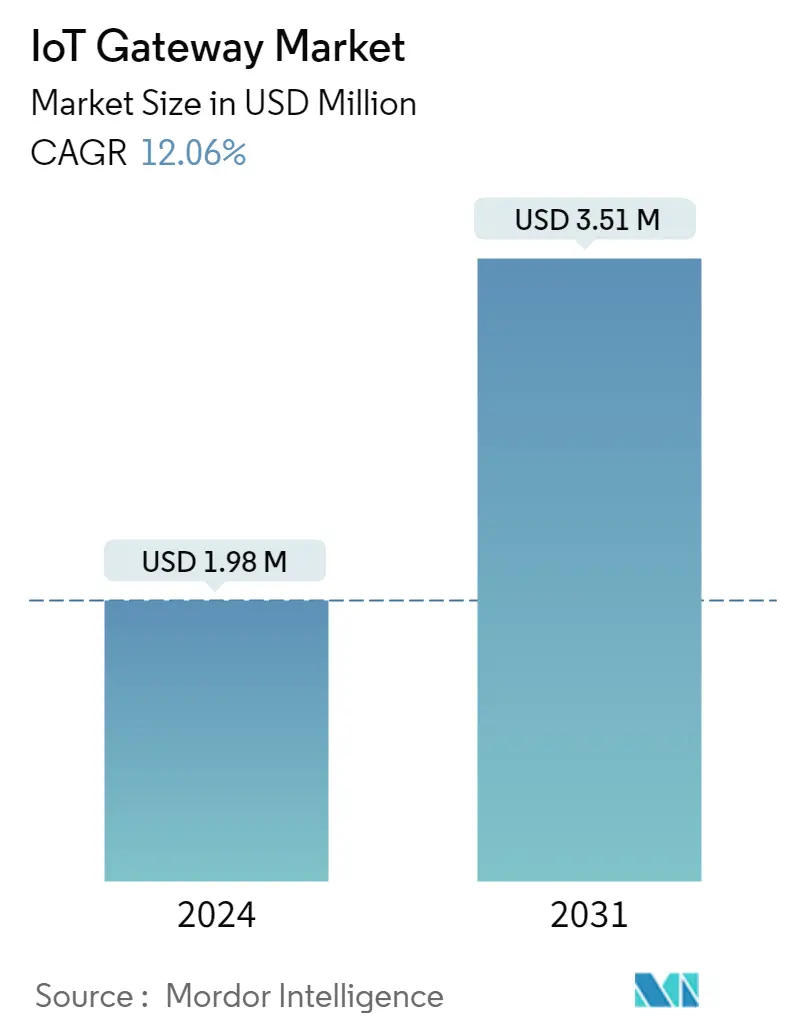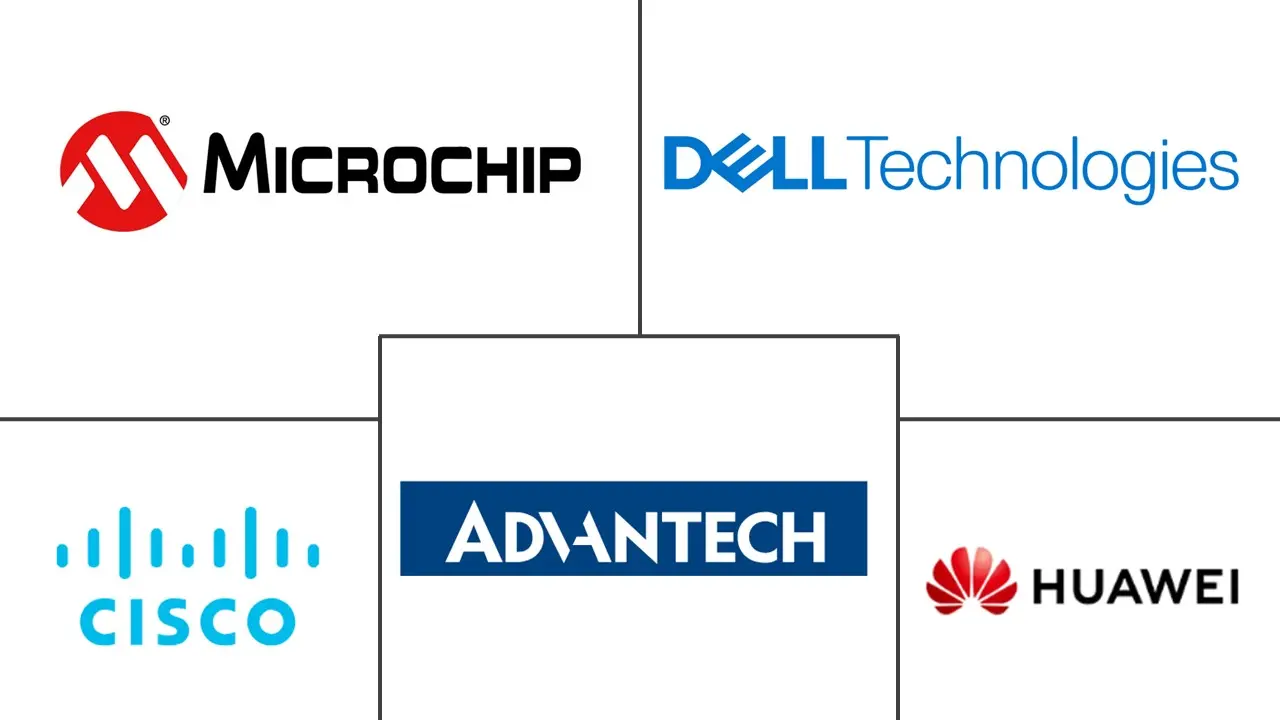Market Size of IoT Gateway Industry

| Study Period | 2019 - 2031 |
| Market Size (2024) | USD 1.98 Million |
| Market Size (2031) | USD 3.51 Million |
| CAGR (2024 - 2031) | 12.06 % |
| Fastest Growing Market | Asia Pacific |
| Largest Market | Asia Pacific |
| Market Concentration | Low |
Major Players
*Disclaimer: Major Players sorted in no particular order |
IoT Gateway Market Analysis
The IoT Gateway Market size is estimated at USD 1.98 million in 2024, and is expected to reach USD 3.51 million by 2031, growing at a CAGR of 12.06% during the forecast period (2024-2031).
. The communication and interaction between devices and objects have been completely transformed by the Internet of Things (IoT). IoT gateways are key intermediaries in enabling frictionless communication between IoT devices and the cloud. They are critical parts of any IoT architecture since they play a crucial role in combining data from sensors, connecting to the internet, and regulating data flow. The global IoT gateway market has grown significantly as businesses from various industries implement IoT solutions to increase productivity, cut costs, and improve decision-making processes.
- The need for IoT gateways has increased as a result of the widespread use of IoT devices and solutions in numerous industries. The necessity for effective and secure data management and transmission is becoming increasingly important as more businesses incorporate IoT technology into their operations. The capabilities of IoT gateways have improved with the development of edge computing. IoT gateway adoption is facilitated by edge computing, which enables processing data closer to the source, lowering latency, bandwidth usage, and dependency on cloud-based resources. Making sure there is strong security and data privacy has become a top concern for enterprises due to the increasing number of IoT devices and potential vulnerabilities. IoT gateways provide encryption, authentication, and safe data transport, acting as a security layer.
- The key drivers for the IoT gateway market include the growth of application-specific MCUs, flexible SOC-type designs, and the emerging development of smart cities. Building electronic circuits within a system-on-chip (SoC) has significant benefits, such as improving efficiency and compatibility while reducing space requirements and development speed. IoT with SoC, including wireless technology, helps prevent the implementation challenges, such as network integration, incompatibility, and reliability issues.
- IoT gateways are increasingly needed to properly manage a variety of devices and data streams as smart cities are developed and IoT-based solutions are integrated into urban infrastructure. The adoption of IIoT-based solutions is integrated into urban infrastructure. The adoption of IIoT applications by the industrial sector to increase operational effectiveness and obtain real-time insights has greatly increased demand for industrial-grade IoT gateways.
- The factors challenging the growth of the IoT gateway market include concerns regarding the security and privacy of user data and the lack of common protocols and communication standards of IoT technology. The standardization communication protocols of IoT technology are at a developing stage. However, the standard protocols are expected to happen in the next few years, making the impact of the challenge gradually low in the next few years.
- The post-COVID-19 era recorded the growth of IoT applications across numerous industries. IoT gateways discovered new cases and potential for adoption in industries ranging from healthcare and manufacturing to agriculture and transportation. Farms were monitored for soil moisture, temperature, and humidity using IoT gateways and sensors. This allowed for precise irrigation and resource management, which enhanced agricultural productivity.
IoT Gateway Industry Segmentation
An IoT gateway is a bridge between IoT devices and the cloud or data center-based IoT platforms and applications that consume the IoT device data. The IoT gateway provides critical functions within an IoT solution. It provides the link from the IoT devices to the required data. It also provides processing power to allow the data captured to be changed based on the input, as pushing out the intelligence of expert systems into the field near the sensors and devices.
The IoT gateway market is segmented by Component (Processor, Sensor, Memory, and Storage Devices), by Connectivity (Bluetooth, Wi-Fi, ZigBee, Ethernet, and Cellular), by End User (Automotive and Transportation, Healthcare, Industrial, Consumer Electronics, BFSI, Oil and Gas, Retail, and Aerospace and Defense), and by Geography (North America (United States and Canada), Europe (Germany, United Kingdom, France, and Rest of Europe), Asia-Pacific (India, China, Japan, and Rest of Asia-Pacific), Latin America, Middle East, and Africa). The market sizes and forecasts are provided in terms of value in USD for all the above segments. The analysis is based on the market insights captured through secondary research and the primaries. The report tracks the key market parameters, the underlying growth influencers, and the major vendors operating in the industry, which supports the market estimations and growth rates during the forecast period.
| By Component | |
| Processor | |
| Sensor | |
| Memory and Storage Device | |
| Other Components |
| By Connectivity | |
| Bluetooth | |
| Wi-Fi | |
| ZigBee | |
| Ethernet | |
| Cellular | |
| Other Connectivity Types |
| By End User | |
| Automotive and Transportation | |
| Healthcare | |
| Industrial | |
| Consumer Electronics | |
| BFSI | |
| Oil and Gas | |
| Retail | |
| Aerospace and Defense | |
| Other End Users |
| By Geography | ||||||
| ||||||
| ||||||
| ||||||
| Latin America | ||||||
| Middle East and Africa |
IoT Gateway Market Size Summary
The IoT gateway market is experiencing significant growth, driven by the increasing adoption of IoT solutions across various industries. IoT gateways serve as crucial intermediaries, facilitating seamless communication between IoT devices and the cloud by aggregating data from sensors and managing data flow. The proliferation of IoT devices has heightened the demand for efficient and secure data management, with advancements in edge computing enhancing the capabilities of IoT gateways. These gateways are essential for ensuring data security and privacy, offering features like encryption and authentication. The market is further propelled by the development of smart cities and the integration of IoT-based solutions in urban infrastructure, as well as the industrial sector's adoption of IIoT applications to improve operational efficiency.
In the Asia-Pacific region, countries like India and China are witnessing rapid expansion in their IoT ecosystems, supported by government initiatives and advancements in connectivity infrastructure. The industrial sector in India is increasingly adopting IoT technologies, driving demand for industrial-grade IoT gateways. Meanwhile, China's focus on technological innovation and digital transformation is fostering growth in the IoT gateway market. The presence of established players such as Cisco Systems Inc. and Dell Inc. intensifies competition, with companies engaging in strategic partnerships and acquisitions to enhance their market offerings. The market's capital-intensive nature presents high barriers to entry, ensuring that competition remains fierce among key players.
IoT Gateway Market Size - Table of Contents
-
1. MARKET INSIGHTS
-
1.1 Market Overview
-
1.2 Industry Value Chain Analysis
-
1.3 Industry Attractiveness - Porter's Five Forces Analysis
-
1.3.1 Bargaining Power of Suppliers
-
1.3.2 Bargaining Power of Consumers
-
1.3.3 Threat of New Entrants
-
1.3.4 Threat of Substitutes
-
1.3.5 Intensity of Competitive Rivalry
-
-
1.4 Assessment of Impact of COVID-19 on the Market
-
-
2. MARKET SEGMENTATION
-
2.1 By Component
-
2.1.1 Processor
-
2.1.2 Sensor
-
2.1.3 Memory and Storage Device
-
2.1.4 Other Components
-
-
2.2 By Connectivity
-
2.2.1 Bluetooth
-
2.2.2 Wi-Fi
-
2.2.3 ZigBee
-
2.2.4 Ethernet
-
2.2.5 Cellular
-
2.2.6 Other Connectivity Types
-
-
2.3 By End User
-
2.3.1 Automotive and Transportation
-
2.3.2 Healthcare
-
2.3.3 Industrial
-
2.3.4 Consumer Electronics
-
2.3.5 BFSI
-
2.3.6 Oil and Gas
-
2.3.7 Retail
-
2.3.8 Aerospace and Defense
-
2.3.9 Other End Users
-
-
2.4 By Geography
-
2.4.1 North America
-
2.4.1.1 United States
-
2.4.1.2 Canada
-
-
2.4.2 Europe
-
2.4.2.1 Germany
-
2.4.2.2 United Kingdom
-
2.4.2.3 France
-
2.4.2.4 Rest of Europe
-
-
2.4.3 Asia Pacific
-
2.4.3.1 India
-
2.4.3.2 China
-
2.4.3.3 Japan
-
2.4.3.4 Rest of Asia Pacific
-
-
2.4.4 Latin America
-
2.4.5 Middle East and Africa
-
-
IoT Gateway Market Size FAQs
How big is the IOT Gateway Market?
The IOT Gateway Market size is expected to reach USD 1.98 million in 2024 and grow at a CAGR of 12.06% to reach USD 3.51 million by 2031.
What is the current IOT Gateway Market size?
In 2024, the IOT Gateway Market size is expected to reach USD 1.98 million.

